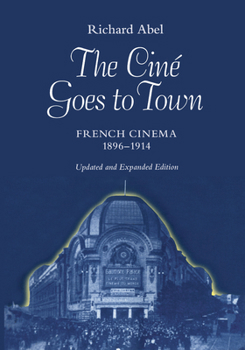The Cine Goes to Town: French Cinema, 1896-1914, Updated and Expanded Edition
Select Format
Select Condition 
Book Overview
Richard Abel's magisterial new book radically rewrites the history of French cinema between 1896 and 1914, particularly during the years when Path -Fr res, the first major corporation in the new industry, led the world in film production and distribution. Based on extensive investigation of rare archival films and documents, and drawing on recent social and cultural histories of turn-of-the-century France and the United States, his book provides new...
Format:Paperback
Language:English
ISBN:0520079361
ISBN13:9780520079366
Release Date:June 1998
Publisher:University of California Press
Length:574 Pages
Weight:2.55 lbs.
Dimensions:1.4" x 7.0" x 10.0"
Customer Reviews
1 rating
Comprehensive history of early French film
Published by Thriftbooks.com User , 22 years ago
Richard Abel has done a massive reasearch job, and impressively documented French silent films from their first showing until the outbreak of World War I. French films were the most popular in the world until the War wiped out the film-making industry for a few years. By then, the American film industry was the world leader. Abel viewed hundreds of still-existing early films in writing this book. The appendix includes a very useful filmography that lists existing French silent films, the archive that holds them, and lists contemporary magazine reviews of the films. This book has very detailed endnotes of his sources. There are quite a few photos from the films that Abel describes.The book is broken up into five parts. The first part documents a history of the French film industry up to 1914, and the audiencies of the time. The next section documents "The Cinema of Attractions (1896-1904), when George Melies was the most popular filmmaker with his "trick" films. Also, the Lumiere Brothers specialized in "actuality" films, and the Pathe company was growing. The next section covers "The Transition to a Narrative Cinema (1904-1907)", where short story films were king. Pathe and Gaumont were the dominant film companies, and Melies was not popular much longer. Next, "The Pre-Feature Single-Reel Story Film" documents the rise of comedies, historical films and even cartoons. Finally, "The Rise of the Feature Film (1911-1914) covers historical epics that were much longer, crime and detective films, and comedies featuring comedians like Max Linder and Andre Deed. The book also explains how both serious films and comedies both affirmed and satirized contemporary French society.If you are new to the study of film history, this book will be way over your head. On the other hand, if you are interested in the development of film narrative and editing, you will be fascinated by this book. My only complaint is that Abel describes so many different examples of films, that it is tough to read a large chunk of this book at one sitting. After an hour or so, all of the plot-lines and camera-work and editing that he describes starts to blur together in your mind. I think that the book might have benefited from more section breaks. Still, this is a fascinating book for the serious silent film fan.






